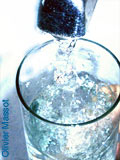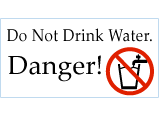- Publications:
- Newsletter:
- How-To Tutorials:
- Consumer Guides:
- Related:

How To Detoxify Your H2O
[Family Circle Archive]

Tap Water Filtration Systems Guide
By Al Ubell and Label Shulman
Published Nov. 6, 1990 - Family Circle Magazine

Water. Should you be drinking what comes out of your faucet?
Though most of us have safe, unpolluted tap water, it is estimated that nearly 70% of Americans are concerned about the quality of their drinking supply. According to the Environmental Protection Agency (EPA), 7.5% of the water systems serving communities of 10,000 or more are not so pure. Various industrial chemicals and pesticides as well as manmade pollutants taint these systems. In fact, two-thirds of all rural households have drinking water that violates some of the EPA's health standards.
So it's not surprising that in 1989 Americans spent more than $1.68 billion on home purifying equipment and water-filtration services. Consumers spent an additional $2 billion on bottled water. Although there are a number of long-term environmental problems that affect our health, the good news is that while Government officials, public-health experts, industrialists and environmentalists debate the water problem and its solutions, there are some pollutants that you can eliminate from your tap water with a filter/purifier system. (See below: “How to De-Tox Your Water” Chart.)
The following information will help you maintain a safe, unpolluted water supply. Among other things, you'll learn when to test your water; where the most worrisome drinking-water pollutants - lead, nitrate and radon - come from, the health hazards they pose and the most effective purification methods for removing them; what emergency measures you should take if your home supply is contaminated; and the major water-treatment devices available to homeowners and where to buy filter systems.
Testing Your Water:
All drinking water should be tested periodically. If you get your water supply from a public system, it's probably protected by the standards of the Federal Safe Drinking Water Act and other state or local regulations. However, if you have your own well or are served by a supply system with fewer than 15 year-round hookups, testing is not required by law.
Much of the concern over drinking water centers on how the water tastes, smells or looks. However, water that could be hazardous to your health often tastes, smells and looks perfectly fine. But if you do notice that your tap water has an unusual taste, odor or color, you should have it evaluated immediately.
Even low levels of contaminants may not be so easy to spot using at-home water-testing methods, and may only be discovered through professional laboratory testing. The results from a laboratory will provide you with most of the information you'll need to make a decision concerning the purchase of a water purifier. But don't expect a testing lab to offer any suggestions or solutions. Corrective measures usually come from water-purification and filtration firms or professional home-water-system consultants. For information on how to get your water tested and for suggested treatment methods, call the Safe Drinking Water Hotline at 1-800-426-4791 or visit the EPA Hotline at: http://water.epa.gov/drink/
There are approximately 50,000 identified water contaminants, and more than 100 of these are subject to water-safety regulations. Although the risk-level of each and the number of people affected varies, all contaminants are potentially hazardous to your health.
The 50,000 identified water contaminants can be divided into six broad categories:
- Biological:
- This category includes bacteria, parasites and giardia, but may also include viruses.
- Heavy-metal salts:
- Some of the most common contaminants in this category include arsenic, lead, mercury. barium and chromium.
- Inorganic chemicals:
- Nitrates, nitrites and fluoride are the three most easily identified contaminants in this category.
- Organic compounds:
- PCB's, pesticides and other industrial chemicals belong in this category.
- Gases:
- Primarily radon that is found in private wells.
- Suspended solid particles:
- This category includes nonsoluble minerals such as coal, clay and sand.
Water Treatment Methods
The following water-treatment methods are available to home-owners. The cost range reflects the variations in capability, sophistication and durability of the systems.
Filtration
These units contain carbon-usually in the form of granulated activated charcoal-and are most effective at removing odors, chlorine, pesticides and organic chemicals, and for improving the taste of the water. Filter units are less effective at removing bacteria, lead and other heavy metals, nitrate, sodium and hard minerals and sediments. Most filter units are designed as replaceable cartridges that are inserted in containers mounted under a sink cabinet. Others can be set on the countertop or in-line on the cold-water pipe. Cost range: $20 to $40.
Reverse osmosis systems
These systems, typically a package consisting of a sediment filter, a reverse-osmosis membrane, a storage tank and an activated carbon filter are best at removing inorganic contaminants, such as ferrous iron, dissolved salts of sodium, lead and pollutants. They are effective at removing 60% to 90% of many minerals. Reverse osmosis systems produce only a few gallons of water a day for drinking or cooking, at the average rate of four to six hours per gallon. Some systems even waste water in the bargain. These slow acting units are installed in-line on the cold-water pipe under the sink or counter top. Cost range: $175 to $600.
Distillation
The common table-top varieties boil water to produce steam, then cool the steam until it condenses back to water, leaving behind anything that won't boil or evaporate, such as metals, salts, sediments and minerals. The boiling process will also kill some microorganisms. These units generally will not remove volatile organic compounds such as benzene, naphtha, chloroform and gasoline. Cost range: $175 to $600.
Aeration
This is the most effective method available for the removal of radon gas, which poses a greater health risk than any other environmental pollutant known to man. The EPA estimates that as many as eight million people have dangerously high radon levels in their water supply. Aeration may reduce water-saturated radon levels by 90% or more. Cost range: $650 to $2,000 plus installation.
Sediment filters
These filters screen out suspended particles found in water, such as asbestos, detergents and ordinary mud and sand. Cost range: $25 and up. Ultraviolet radiation purifiers These are very effective for removing microorganisms such as bacteria and giardia. They work especially well in homes that use well water. These purifiers are usually installed in conjunction with other types of filters. Cost range: $300 to $700.
Which of the water-treatment systems available to homeowners (see “Treatment Methods,”) will remove the contaminants found in your drinking water - if any are found? Different water-treatment systems are designed to remove or treat different contaminants. Here's what you should do before purchasing an at-home water-treatment kit:
- Have a sample of your drinking water tested by an independent, state-certified testing laboratory to see if there really is a problem that needs to be corrected. (For phone numbers, consult the Yellow Pages under “Laboratories-Testing.”).
- If you subsequently find that your drinking water is contaminated, consult our chart on “How to De-Tox Your Water” to see if the pollutants contaminating your water are listed. If not, you can research other available purification systems for your pollution problem by consulting Consumer Reports studies and reviewing available sales literature.
- Learn about each product's performance capabilities, maintenance provisions, operation and warranty coverage.
- Check the seller's reputation or customer references before you sign a sales contract.
- Before doing business with any company, call your Better Business Bureau or consumer-protection agency to find out if there have been any complaints against the company.
IF YOU SUSPECT A PROBLEM:
If you believe that your family's drinking water may be contaminated, anyone of the following agencies can provide you with information on water-testing services:
- the local department of health, which may have testing facilities;
- your local Environmental Protection Agency office;
- local college or universities-the departments of chemistry, natural resources and agronomy may offer testing services;
- your local cooperative extension agency, which offers information about water testing in your area;
- The Water Quality Association, a trade group that offers information on improving water quality.
- Various water treatment and/or plumbing-supply companies can also help.

EMERGENCY MEASURES:
If testing confirms your suspicions and your home drinking water contains inorganic and organic contaminants. such as mercury, lead, benzene or arsenic, you and your family should take the following precautions immediately:
- Don't use your water for either drinking or cooking; instead, use bottled water until yours is certified as safe for consumption.
- If the problem is bacterial in nature, try boiling drinking water until the problem can be corrected.
If anyone in your family becomes nauseous or ill after drinking contaminated water contact your physician or hospital emergency room.
Chart: How To Detoxify Your Water
| Common Pollutants / Contaminants | Origin | Health Impact | EPA Max. Levels | Effective Purifying Methods |
|---|---|---|---|---|
| Arsenic | Found naturally in the environment, especially in the western United States. Also the result of smelting operations and industrial waste runoff. Often used in insecticides. | May cause chronic fatigue and energy loss if ingested over long periods of time. Also affects the skin and nervous system. | 0.05 mg per liter | Reverse osmosis, distillation |
| Asbestos | The result of corroding asbestos-cement pipes in water-distribution systems. Also from the manufacture of cement products, floor tiles, paints, caulking and paper products. | Possible cancer-causing agent. | proposed 7.1 million fibers per liter | Consult an expert in the field |
| Barium | Naturally present, but not widespread. May enter water system through industrial-waste discharge. | Large quantities can increase blood pressure significantly. | 1.00 mg per liter | Reverse osmosis, distillation |
| Benzene | From leaking fuel tanks, industrial effluents. Also a solvent used to make chemicals, paints, plastics and dyes. | Possible cancer-causing agent. | 0.005 mg per liter | Reverse osmosis, activated charcoal |
| Cadmium | Found in galvanized pipes and fixtures; in water discharges from electroplating, insecticide, metallurgy, photography. | Has been known to affect kidney function. | 0.01 mg per liter | Reverse osmosis, distillation |
| Fluoride | Found naturally in all drinking water. | High levels can cause brown spots on teeth. In proper amounts in drinking water, it prevents cavities. | 4.00 mg per liter | Reverse osmosis, distillation |
| Lead | Sound in lead pipes, auto exhausts and old paint. | Excessive amounts can cause nervous-system disorders, and brain and kidney damage. | 0.05 mg per liter | Reverse osmosis, distillation |
| Lindane | Pesticide. | Highly toxic. May cause cancer. | 0.004 mg per liter | Distillation |
| Mercury | Found in nature; also from industrial and agricultural processes. Accumulates in the food chain, especially in fish. | Low doses over time can cause chronic poisoning. High doses can cause acute poisoning. | 0.002 mg per liter | Distillation |
| Micro-Biologicals (Bacteria, Viruses) | From human and animal fecal matter. | May cause gastroenteric infection or disease. | 0.0 mg per liter | Ultraviolet radiation, chemical treatment and distillation |
| Nitrate | Found in fertilizers and in food preservatives. | May cause anemia. | 10.00 mg per liter | Reverse osmosis, distillation |
| Radon | A gas found in ground water, and from the decay of naturally occurring uranium. | May cause cancer. | No EPA standard set | Aeration |
| Vinyl Chloride | From the manufacture of PVC piping and plastics. | Possible cancer-causing agent. | 0.002 mg per liter | Aeration |
| 2,4-D | Found in herbicides that are used to control broadleaf and aquatic weeds. | May cause liver and kidney problems. | a proposed level of 0.07 mg per liter | Distillation, activated charcoal |

Copyright © Alvin Ubell, Label Shulman & Family Circle Magazine - 1990
Accurate Building Inspectors ®
www.AccurateBuilding.com




